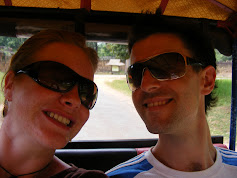Goochickant, aka vaguely ridiculous meals I have enjoyed

For Christmas Marie and I drove up to Edinburgh, in the hope of our first Christmas away from New Zealand being a white one. Sadly this did not eventuate, so we consoled ourselves by attacking a goochickant. That is, a deboned goose stuffed with a deboned chicken stuffed with a deboned pheasant. Who dreams this kind of roast up, I want to know. As per the photo, you serve this by slicing vertically through the roast to yield a serving of layered poultry.
Overall verdict: strongly positive.
Pros: very tasty, and I somehow managed to cook the innermost pheasant without drying out the outermost goose.
Cons: It is not the kind of thing you want to eat every day, as the sheer size is vaguely ridiculous. Especially for three people, haha. More thoughts and the cooking techniques below the fold.
The roast prior to cooking, just to give you some idea of how big this was. Also, these birds have been mostly deboned so it is 5kg of pure meat. Mmmm bird flu.
We roasted the megabird covered in foil for a total of five hours (followed by resting of 20 mins), with basting every hour. The liquid I used for basting was the poultry fat which came off the bird, so I was basting with pure fat. At least goose fat is the good type of fat (is the good one hydrogenated or unhydrogenated? I forget). Temperature of roasting: 180 for the first hour, 150 after that.
I used the Nigel Slater technique for vegetables of putting the roast on an oven rack and the vegetables underneath, so the fat from the roast dripped onto the vegetables (potatoes, kumara, garlic, onions, parsnips, carrots). As there was a lot of fat coming off the roast the vegetables started to caramelise due to the combination of low heat, much fat, and long cooking time.
In fact, every time I basted I took more liquid from the vegetable tray than I replaced, so by the end of the roast I had a pint glass full of excess meat juices. And this was after I used some of the excess meat juices for the gravy, which was adulterated by 300 grams of cranberries which Brendan had procured from somewhere and red wine. Purple gravy is good.
The goochickant was served with the aforementioned vegetables and gravy, and also some brussel sprouts to put some green on our plates.
We didn't manage to polish the entire roast off on Christmas day. We got about halfway through, so the menu for the next few days is goochickant sandwhiches, goochickant salad, goochickant insert method of eating cold meat here.
I had previously heard that three bird roasts sometimes dried out the outer bird. I think the way we avoided this fate here was a combination of a)covering the bird, b) cooking at a low temperature for a long period, and c) frequent basting. I have had goose once before, and it was a little tough. In the goochickant the goose was nice and tender, so crisis averted here.
While I enjoyed this roast immensely, I don't think I would have it again next year in the same iteration. Part of this is the novelty value of a three bird roast, which is now gone. Also, I think I would like to make my own version next time. Hugh Fearnley-Whittingstall of River Cottage fame has a recipe for a ten bird roast. For this he doesn't stuff nine whole birds into the tenth one, rather he takes the breasts from the nine smallest birds and puts them into the largest bird. Rather than ten birds, I could strip the meat off a couple of smaller birds, and put them into a goose. Britons like their birds, you can procure everything from partridges to pheasants at the numerous farmers' markets, so getting hold of exotic poultry is not really an issue.


1 comment:
Wow, I am impressed - and now understand the theory behind the multiple stuffed bird as I was struggling to see the appeal of removing the bones from the aforementioned. Thank goodness for butchers!
The bird (s) looked really good going by the pics - obviously a fare bit of shrinkage went on though going by the before and after shots.
Yep, I agree long and slow on a lower temp is the way to go with roasting. We now roast all our meat in a heavy casserole dish with the lid on and only remove it to crisp up the outside of the meat at the last minute.
Next time you do a goose or duck save the fat and freeze it. It can then be used to make THE BEST roast potatoes you will ever eat.
Les x
Post a Comment